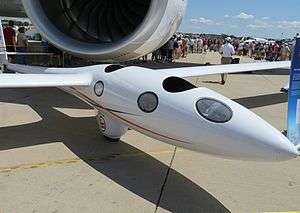Windward Performance Perlan II
| Perlan II | |
|---|---|
 | |
| Perlan II on display with an Airbus A350 XWB for scale in background | |
| Role | Glider |
| National origin | United States |
| Manufacturer | Windward Performance |
| Designer | Greg Cole |
| First flight | 23 September 2015[1] |
| Status | Under development |
| Primary user | Perlan Project |
| Unit cost |
$1.4 to $2 Million U.S. |
The Windward Performance Perlan II (English: Pearl) is an American mid-wing, two-seats-in-tandem, pressurized, experimental research glider that was designed by Greg Cole and built by Windward Performance for the Perlan Project.[2]
The aircraft first flew on 23 September 2015 at Redmond Municipal Airport, Oregon.[1]
Design and development
The Perlan II is a follow-up design to the successful Perlan I and has as its design goal a flight exceeding 90,000 ft (27 km) in altitude. The project's goals include science, engineering and education. The aircraft will be used to study the polar vortex and its influence on global weather patterns.[2] The program also hopes to beat the 85,069 ft altitude record set in 1975 by a SR-71.[3]
The aircraft is made from composites. Its 83.83 ft (25.55 m) span wing has a high aspect ratio of 27:1 and is equipped with airbrakes. The pressurization system produces an 8.5 psi differential, although the two-person crew will wear pressure suits for safety. The landing gear is a retractable monowheel gear. Because the aircraft will operate at extreme altitudes, in only 3% of sea level atmospheric pressure, it will also be flying at true airspeeds in excess of 0.5 Mach.[2] The aircraft was designed to minimize flutter and manage shock wave formation.
The original funding for the Perlan Project was provided by Steve Fossett and he flew the Perlan I, along with test pilot Einar Enevoldson to a glider altitude record of 50,761 ft (15 km) in the mountain waves of El Calafate, Argentina on 30 August 2006. Fossett was killed in a light aircraft crash a year later and the project floundered without funding. Since then more than US$2.8M has been raised to build the Perlan II, including a donation from Dennis Tito.[2] In November 2013, a crowd-funding effort was undertaken. In August 2014 Airbus became a partner in the project.[4]
The Perlan II was originally expected to fly in early 2013 and will start with some flights in the US Sierra Nevada mountain wave. The record setting and research flights are intended to start in southern Argentina in April 2016,[5] by Einar Envoldson[2] or Perrenod using rebreather oxygen systems.[6] The aircraft was displayed at AirVenture in July 2015.[7][8][6] First flown in September 2015, research flights to 100,000 ft (30,480 m) are expected to start in 2019.[7]
Specifications (Perlan II)
Data from FreeFlight[2]
General characteristics
- Crew: two
- Length: 33.33 ft (10.16 m)
- Wingspan: 83.83 ft (25.55 m)
- Height: 7.25 ft (2.21 m)
- Wing area: 263 sq ft (24.4 m2)
- Aspect ratio: 27:1
- Gross weight: 1,800 lb (816 kg)
Performance
- Never exceed speed: 377 kn (434 mph; 698 km/h) 377 true airspeed, 56kts indicated
- Service ceiling: 90,000 ft (27,000 m)
- G limits: +6/-4
See also
- Aircraft of comparable role, configuration and era
- Related lists
References
- 1 2 "Perlan 2 Glider Completes First Flight". AVweb. Retrieved 26 September 2015. Video
- 1 2 3 4 5 6 Staff report, The Perlan II project continues to develop, pages 24-25. FreeFlight, the Journal of the Soaring Association of Canada, Autumn, 2011.
- ↑ "Gliding To The Edge Of Space". Retrieved 15 November 2013.
- ↑ "Airbus To Join Perlan Project". AVweb. Retrieved 28 July 2015.
- ↑ "Perlan 2 Glider Getting Set For First Flight". aero-news.net.
- 1 2 "The Edge of Space: Airbus' Perlan 2 Aims to Break World Altitude Record". World Industrial Reporter.
- 1 2 "New Perlan Glider Debuts At Oshkosh". AVweb. Retrieved 28 July 2015.
- ↑ "High Hopes: Airbus Perlan Mission II Glider Built to Become 'Highest-Flying Winged Aircraft Ever' to Attempt Historic First Flight". Marketwire.